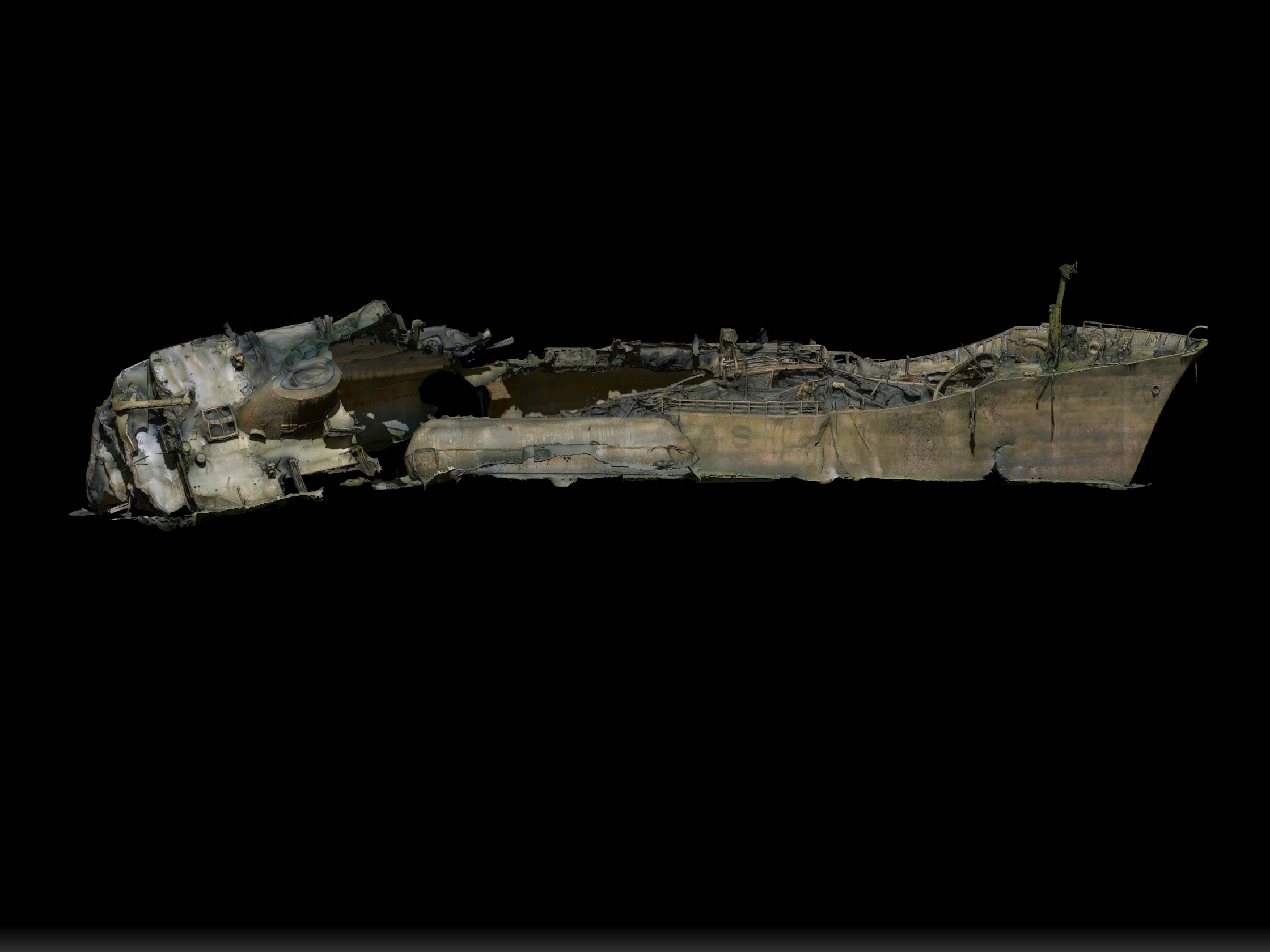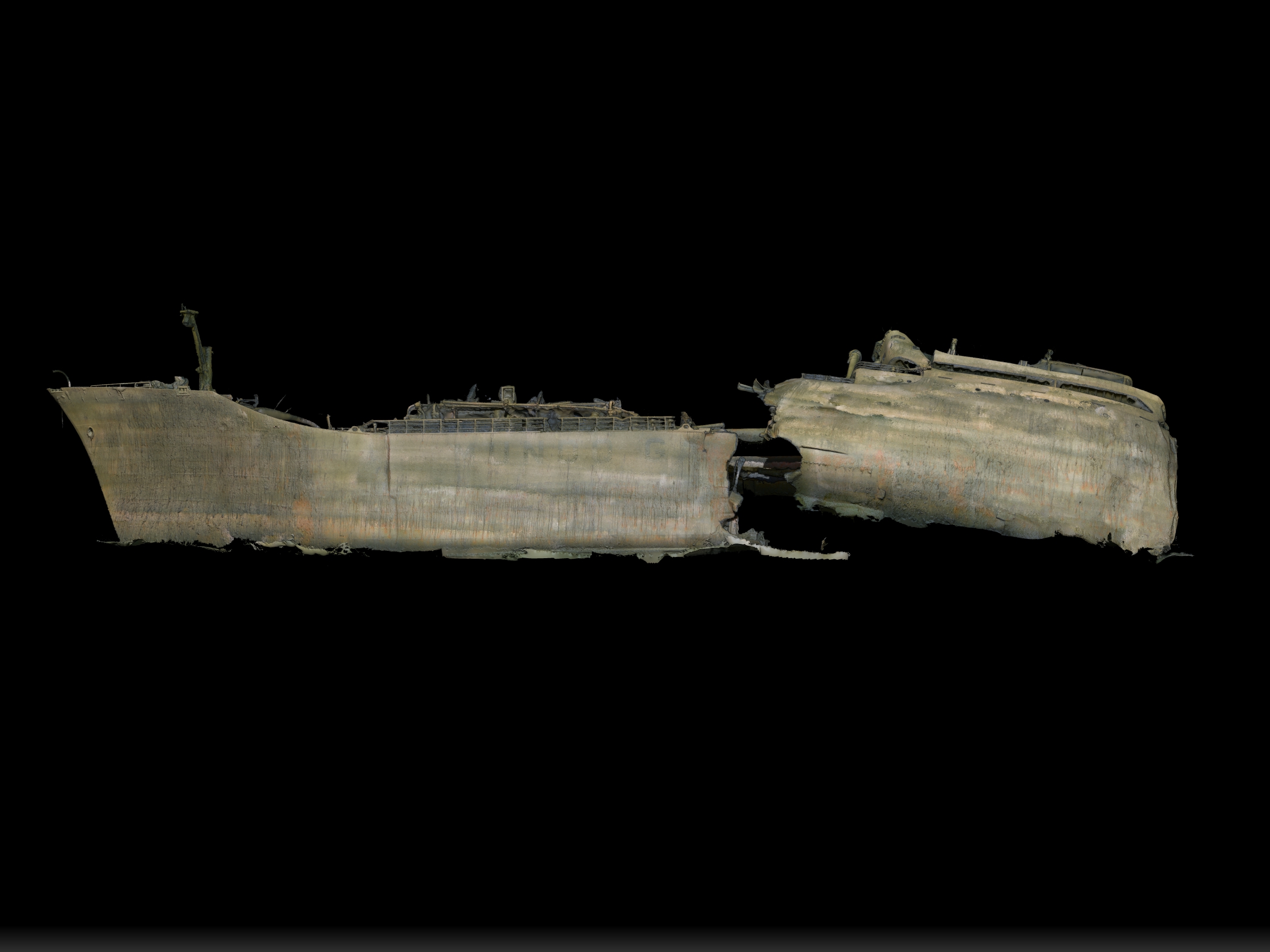Mundogas Oslo
In September 1966, the vessel Mundogas Oslo collided with the Finnish ship Saara in dense fog and sank. At the time, she was carrying 2,095 tonnes of ammonia. In 2025, the wreck, thought to contain both environmentally hazardous oil and ammonia, was surveyed on behalf of the Swedish Agency for Marine and Water Management (SwAM).

In 2021, a side-scan and photogrammetry survey of the Mundogas Oslo was carried out, capturing 31,000 still images. Photogrammetry is a technique for taking measurements from photographs to determine the size, shape, and position of photographed objects. Together, these methods provided a comprehensive view of the wreck. Photo: Ocean Discovery.
The wreckage
On 22 September 1966, the vessel was on route from Fredericia, Denmark, to Nystad, Finland, carrying 2,095 tonnes of liquid ammonia, cooled to –10 °C. In dense fog, reportedly limiting visibility to about 300 metres, she collided with the Finnish vessel Saara on her starboard side, causing her to sink. The stern went under first, while the bow remained afloat for some time.
Cargo and fuel tanks
The ship’s bunkering capacity was 944 tonnes, with 32 tonnes dedicated to lubricating oil. There are no records of the actual bunkering volume aboard at the time of the sinking, but SwAM estimates, based on previous salvage operations, that up to 100 tonnes of oil (diesel and lubricants) may remain in the wreck.
There are no reports of oil leakage from the wreck in the years following the sinking. However, during the Ocean Discovery survey in 2021, oil droplets were observed on the water’s surface, most likely originating from the wreck. A large crack in the wreck may well have caused oil leakage, although this could not be confirmed.
The cargo comprised 2,095 tonnes of liquid ammonia in refrigerated pressurized tanks. A salvage company’s report from 1967–1969 estimates that the starboard aft tank and starboard forward tank were intact, and about half the port aft tank remained. In total, approximately 940 tonnes of ammonia were estimated to remain in the wreck, according to Coast Guard data from 2012.
Condition and location of the wreck
The wreck lies at coordinates 726750,119 E and 6720426,75 N (E SWE99 TM, N SWE99 TM) on a seabed comprising soft sediment with areas of rock and boulders nearby. The bottom depth is 67 m, and the highest point of the wreck lies at 53 m. Visibility is described as very poor, ranging from 0.5 to 2 metres. The wreck is broken by a 5–6 metre long through-going crack just forward of the superstructure. The stern also shows severe damage, both at the sternpost and the port bottom, exposing the different deck levels of the ship.
Environmental risk assessment
Mundogas Oslo was listed among the most environmentally hazardous wrecks in Swedish waters, based on a government assignment conducted by the Swedish Maritime Administration between 2009 and 2015. A probabilistic risk assessment using the VRAKA tool was performed for about 30 wrecks on that list.
Sensitive nature in the surrounding area
Sensitive natural environments are located close to the wreck and could have been impacted by any leak. To the southwest lies the Gräsö Eastern Archipelago Nature Reserve, while to the northwest is the Natura 2000 site Finngrunden. Southeast of the wreck (towards Åland) is the Signilskär-Märket bird area, consisting of 50 islands and covering some 22,500 hectares. It is known for rich birdlife, breeding, migrating, and wintering, and is designated as a “Ramsar site”. The Ramsar Convention is a global nature conservation convention to preserve wetlands and aquatic environments.
The area is also a core habitat for the grey seal in the Northern Baltic Sea, and cod stocks in the waters south of Åland (Åland Sea) are reportedly healthy, with small-scale net fishing yielding good catches.
Detailed investigation in 2025
In July 2025, SwAM’s contractor JD-Contractor, conducted an investigation of Mundogas Oslo. All bunkering tanks included in the assignment were examined. No oil was found in any compartment, indicating it had likely leaked into the marine environment over time. During the investigation, results also showed that the stern was more damaged than previously known, meaning oil had most likely escaped through that route.
Regarding the ammonia cargo tanks, these too were successfully examined and found incapable of still containing ammonia. Either the pipelines to the tanks were broken, or bolts on the tank tops were corroded or missing, allowing seawater to enter. Contact between water and liquid ammonia causes a vigorous reaction, leading to vaporization. The resulting pressurized ammonia gas would then be able to escape into the surrounding water and be diluted. This process most likely then continued until no ammonia remained in the tanks, indicating that no ammonia is still contained within.

Mundogas Oslo. Photo: Ocean Discovery
Background information
- The LPG tanker Mundogas Oslo was built in 1963 at Drammen Slip & Verkstad in Drammen, Norway.
- It was powered by two 6-cylinder Nordberg Mfg Co. Milwaukee diesel engines.
- Length: 91.2 m; Beam: 14.7 m; Draught: 7.22 m; Gross Tonnage (GRT): 3,645 tonnes.
- It had six cylindrical cargo tanks with a total capacity of 3,400 tonnes - two on deck, with the rest in the cargo hold.



